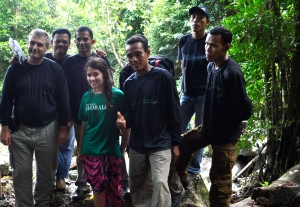by Angie
We wanted our last day in Aceh to be an adventurous one, so on Sunday we booked a ride into the Indonesian jungle an hour from Banda Aceh. Our guides were a Dutch expat named Mendel and his posse of five former fighters from the Free Aceh Movement (GAM), which until 2004 had waged a bitter war against the Indonesian government. I especially was eager to speak with the ex-combatants and visit former battle sites as I am researching their reintegration into Indonesian society for my article. With such company, our group knew that the day would be anything but typical.
We were dropped off at what looked like the end of civilization. Ahead of us laid a bridge, beyond which the road simply ended, replaced by a narrow trail weaving through the dark ravines and steep mountains of the Indonesian jungle. After only fifteen minutes of walking through the canopy, I happened to kick a square metal container lying on the ground. “It used to hold ammunition” said Mendel nonchalantly when he saw the puzzled look on my face. That’s when the history of the place hit me. Six years ago, in this very spot, our tour guides had been crouching behind these very bushes, launching attacks and dodging bullets.
Later in the day, as the trail became steeper and more treacherous, the ex-combatants took the lead, grabbing our hands as we struggled to find footing. When we reached a clearing in the forest where our guide informed us we would break for lunch, our ex-combatants suddenly procured, seemingly out of nowhere, a large watermelon, over fifteen bottles of water, and individual bulges of chicken and rice wrapped in palm leaves. One of them sliced the watermelon like butter with a giant knife that he had just used to bushwhack our trail. These men who had, in these very woods, stared death in the face, were now opening their world to strangers – and even feeding them lunch.

My thoughts we interrupted by a loud clanking which broke the silence around us, and I looked up in time to see four long wooden planks tumble to my side. “Illegal logging,” announced Jeff, our editor-in-chief, with confidence. I laughed. I didn’t realize he was being serious until our guides begun telling us how frequently they see these men hauling large pieces of wood out of the forest. It took a couple of minutes for me to register exactly what was happening: the very small, rather cute old man throwing planks down a waterfall was trying to make a living for himself by destroying the forest, one tree at a time. Was it bad that I felt sorry for him?
Brushing the question aside, we climbed the steepest slope yet and arrived at our final destination: a secluded waterfall. We became little children, splashing into the water, climbing rocks covered in moss to reach a higher, more secluded overlook, and handing our cameras to our ex-GAM friends who laughed and kept us from falling more than a few times. We lost track of time and were eventually told to head down by our still-amused guides.
On the car ride back, I reflected on a conversation I’d had earlier that day with Mendel. I had explained to him what I was writing my article about and he had translated a few questions for the guides, who spoke only broken English. After helping for a while, he turned to me and said, “look, Angie. The GAM is the anchor for men like them. Now, their anchor is gone.” By being in the jungle, he explained, “they’ve missed out on society for all these years.”
After handing each of our guides 50,000 Rp in appreciation and leaving the forest in our hired cars, we collapsed in the seats, staring idly at the passing jungle and falling asleep with minds filled with unanswered questions.